
Percy Sinclair Pilcher (1866 - 1899)
Percy Pilcher Engineer and pioneer of unpowered flight. Born in Bath (England) of a Scottish mother, Pilcher briefly served in the Royal Navy before becoming an apprentice at the Govan ship-builders Randolph, Elder and Co. He took up a lecturing post in the University of Glasgow (1891) and proceeded to design and build gliders. His first machine, the Bat flew successfully from a hill overlooking the Firth of Clyde at Cardross. However, Pilcher was fatally injured when his fourth machine, the Hawk, crashed after many successful flights. This glider is now preserved in the Museum of Flight (East Lothian).
It should be noted that much of this webpage and indeed most of what is written about Pilcher derives from the indepth study by Philip Jarrett Another Icarus : Percy Pilcher and the Quest for Flight. Smithsonian Press, 1987, ISBN 0-87474-556-X. Any study of Pilcher should begin (and end?) with this book.
Percy Pilcher One rainy day in October 1899, a crowd stood in the rain at Stanford Park, near Market Harborough, in England, to see Percy Pilcher make his first test of a power-driven triplane glider (4 hp engine weighing 40 lbs). Percy Pilcher looked at the sky and shook his head. The weather was not to be trusted. But the crowd grew restless. The long wait and the rain were fast convincing them of the soundness of logic they had often repeated, "If man had been intended to fly, God would have given him wings."
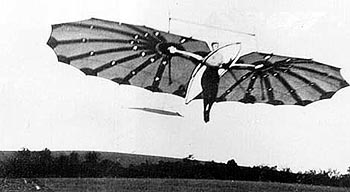 Percy Pilcher, "Hawk" glider, the "Knob", Eynsford, 1897 (Jarrett, 1987, p.78)
Not to disappoint the crowd utterly, Pilcher prepared to make a glider flight in his tried and trusty "Hawk" as he had done many times before. All was ready. Pilcher took his place and the machine was being towed rapidly over the ground when the tow-rope broke. The crowd murmured in disgust. Hastily the rope was repaired and another start was made. Breathlessly, they saw Pilcher sailing splendidly into the air, up and up to a height of nearly thirty feet--suddenly a guide wire in the tail snapped. The tail collapsed. And before the eyes of the crowd could credit what they saw, down came Pilcher and his "Hawk" in a heap upon the crowd. Two days later Pilcher passed away without regaining consciousness, one of the earliest martyrs to aviation.
Percy Pilcher Percy Pilcher (1866 - 1899) is one of the few British participants in the fevered race to invent the airplane. Pilcher patterned his approach after Otto Lilienthal, developing hang gliders before engaging the problems of powered flight.
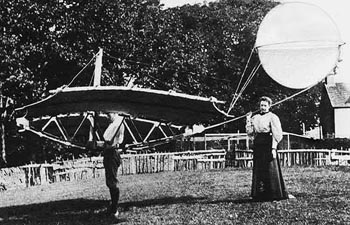 Percy Pilcher and Ella, "Beetle" glider, mid 1895 Auchensail farmhouse, (Jarrett, 1987, p.20) Download a 750pixel image
Pilcher developed 4 different hang gliders: the Bat, the Beetle, the Gull, and the Hawk. Pilcher seldom tested his craft in free-flight. Instead, he attached a rope to the craft which was used to tow the craft. The tow rope acts as a stabilizing force on the glider, which makes it very difficult to compare Pilcher's accomplishments against those of others.
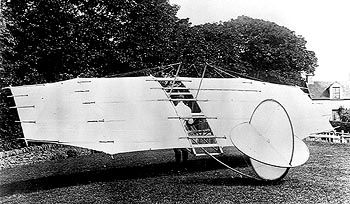 Percy Pilcher, "Beetle" glider, mid 1895 Auchensail farmhouse, (Jarrett, 1987, p.20) Download a 1000pixel image http://invention.psychology.msstate.edu
At the time of his death from a gliding accident, Pilcher was preparing a powered hang glider.
 Percy Pilcher, "Hawk" glider, the "Knob", Eynsford, 1897, (Jarrett, 1987, p.78) Download a 1000pixel image http://invention.psychology.msstate.edu
Percy Pilcher's "Hawk" glider, 1896 Percy Pilcher's Hawk is the oldest heavier-than-aircraft in the United Kingdom. Constructed in 1896 by Percy Pilcher and his sister Ella, the design was influenced by gliders of Otto Lillienthal, the German pioneer aviator. Percy Pilcher is recognised as the founder of glider flight in Britain; the Hawk was his last and most successful of four gliders built and flown.
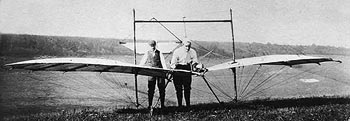 Percy Pilcher, "Hawk" glider, the "Knob", Eynsford, 1897 (Jarrett, 1987, p.78) Download a 1000pixel image
On September 30th 1899, whilst giving a public demonstration, the Hawk suffered structural failure and plunged to the ground, Pilcher died from his injuries two days later. Repaired by the Royal Aeronautical Society in 1909, the Hawk was donated to the Royal Scottish Museum that year, it was suspended from the ceiling of the main gallery until shifted to the Museum of Flight in 1993.
Percy Pilcher In 1895, the Scot Percy Pilcher built a glider called the Bat. He visited Otto Lilienthal in Germany and consulted him about glider design. Pilcher's further gliders incorporated Lilienthal's configuration and technique, particularly the way that Lilienthal suspended himself from the glider. In 1896, Pilcher built and flew his most successful glider, the Hawk.
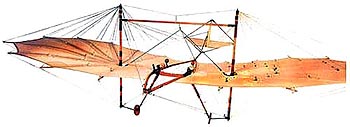
Percy Pilcher's "Hawk" glider, Replica Dorling Kindersley
It had a wheeled undercarriage and tow-line takeoff and flew up to 750 feet (229 meters). Unfortunately, he was killed in a gliding accident in 1899 just as he was preparing to test a powered triplane. Pilcher's death signaled a pause in Britain's participation in practical aviation. It was another decade before Great Britain developed any even moderately successful aircraft.
flight100.org The hang-glider of Maxim's one-time assistant, Percy Sinclair Pilcher, benefited considerably from the advice and gliding experience afforded by the German hang-gliding pioneer, Otto Lilienthal, near Berlin in 1895 and 1896. Pilcher progressed with varying success through four gliders of his own design and the fourth, the Hawk of 1896, like its predecessors, incorporated the Lilienthal practice of radiating rods for the wing structure (for ease of ground transit) and the dubious choice of an up-hinging tail unit. Although Pilcher enjoyed some success with this glider, the structural failure of its tail assembly in 1899 caused a crash that killed him. Prior to this, he had been working on a powered development of the Hawk design, using a petrol engine driving a pusher propeller, but there is no indication he intended to attempt aerodynamic control.
Percy Pilcher's "Hawk" glider, 1897 When I first learned Percy Pilcher was experiencing with gliders like Lilienthal, in Cardross, near Glasgow several years ago, I began a search for him. I was successful in finding is sister Ella, and she kindly made an introduction. I introduced myself as a reporter from a scientific magazine and other publications, but since then we have become true friends. We have frequently met over the past few years and I have had the opportunity to witness his magnificent gliders in flight on several occasions. The first glider I saw in flight was "The Bat". Such pretty apparatus. Sometimes it seemed to me to resemble a giant moth, yet at a slightly different angle, I found the likeness to be closer to that of a bat. The fabric was beneath the ribs and the glider could be break apart if carried away. The fin and tailplane were circular. The Bat was hard to handle and Pilcher decided to begin to work on another design. This next design Pilcher called "The Beetle". It was a huge glider with flat wings. The wings There wasn't any dihedral, like The Bat, however the excessive weight and the difficulty in control make him return once again to his to Bat. I believe it was around the end of 1895 when he began to tell me his plans for a new design. "The Gull", as Pilcher called it, it had two disc tail surfaces as well as the "Bat". On the tips of the spars of each wing there was 2 vertical bamboo longposts where the wires were connected. This glider was lighter than the Beetle. On my recent visit, Pilcher was busy constructing an improved Beetle called "The Hawk". He told me of his plan to attach an engine to this glider as soon as possible and try a powered flight. He invited me to stay a couple of days as he was planning his first public demonstration of his flights in an effort to generate excitement and perhaps attract some investors. He is need of financial support for his experiments. He has also invited some scientists and men of wealth, with the thought they will see his flights and be inspired to invest in the dream of powered flight. As I was helping him with the apparatus in the morning of the demonstration, he continued to talk of his hopes to persuade these people about the possibility of the gliding and powered flight. On June 20, 1897 he impressed his audiences in the first public demonstration of his flights. Very few had ever seen him gliding in his beautiful machines, and I count myself as fortunate to have been witness to several of his marvelous flights previously. Pilcher first demonstrated a towed flight. Miss Dorothy Pilcher, Percy's cousin, glided downhill. He assisted her while another pulled the cable. After this flight, he also took off in a towed flight. He was pulled downhill in a towed by three boys, flying horizontally at a height of 80 feet. The knot slipped and Pilcher was in free flight, demonstrating all the beauty of flying the apparatus. He balanced himself and controlled the glider as he landed, slowly descending upon the valley. When he touched down all the people cheered with such a beautiful flight. I think that Pilcher will be successful in his experiments in attaching an engine to his winged beauty and fly away. See him gliding is an everlasting pleasure. He is a true Daedalus.
John Bart
A History of Aeronautics
VII. Pilcher In England Lilienthal's work was carried on by Percy Sinclair Pilcher, who, born in 1866, completed six years' service in the British Navy by the time that he was nineteen, and then went through a course of engineering, subsequently joining Maxim in his experimental work. It was not until 1895 that he began to build the first of the series of gliders with which he earned his plane among the pioneers of flight. Probably the best account of Pilcher's work is that given in the Aeronautical Classes (papers Ed.?)issued by the Royal Aeronautical Society, from which the following account of Pilcher's work is mainly abstracted.[*] The 'Bat,' as Pilcher named his first glider, was a monoplane which he completed before he paid his visit to Lilienthal in 1895. Concerning this Pilcher stated that he purposely finished his own machine before going to see Lilienthal, so as to get the greatest advantage from any original ideas he might have; he was not able to make any trials with this machine, however, until after witnessing Lilienthal's experiments and making several glides in the biplane glider which Lilienthal constructed. The wings of the 'Bat' formed a pronounced dihedral angle; the tips being raised 4 feet above the body. The spars forming the entering edges of the wings crossed each other in the centre and were lashed to opposite sides of the triangle that served as a mast for the stay-wires that guyed the wings. The four ribs of each wing, enclosed in pockets in the fabric, radiated fanwise from the centre, and were each stayed by three steel piano-wires to the top of the triangular mast, and similarly to its base. These ribs were bolted down to the triangle at their roots, and could be easily folded back on to the body when the glider was not in use. A small fixed vertical surface was carried in the rear. The framework and ribs were made entirely of Riga pine; the surface fabric was nainsook. The area of the machine was 150 square feet; its weight 45 lbs.; so that in flight, with Pilcher's weight of 145 lbs. added, it carried one and a half pounds to the square foot. Pilcher's first glides, which he carried out on a grass hill on the banks of the Clyde near Cardross, gave little result, owing to the exaggerated dihedral angle of the wings, and the absence of a horizontal tail. The 'Bat 'was consequently reconstructed with a horizontal tail plane added to the vertical one, and with the wings lowered so that the tips were only six inches above the level of the body. The machine now gave far better results; on the first glide into a head wind Pilcher rose to a height of twelve feet and remained in the the air for a third of a minute; in the second attempt a rope was used to tow the glider, which rose to twenty feet and did not come to earth again until nearly a minute had passed. With experience Pilcher was able to lengthen his glide and improve his balance, but the dropped wing tips made landing difficult, and there were many breakages. In consequence of this Pilcher built a second glider which he named the 'Beetle,' because, as he said, it looked like one. In this the square-cut wings formed almost a continuous plane, rigidly fixed to the central body, which consisted of a shaped girder. These wings were built up of five transverse bamboo spars, with two shaped ribs running from fore to aft of each wing, and were stayed overhead to a couple of masts. The tail, consisting of two discs placed crosswise (the horizontal one alone being movable), was carried high up in the rear. With the exception of the wing-spars, the whole framework was built of white pine. The wings in this machine were actually on a higher level than the operator's head; the centre of gravity was, consequently, very low, a fact which, according to Pilcher's own account, made the glider very difficult to handle. Moreover, the weight of the 'Beetle,' 80 lbs., was considerable; the body had been very solidly built to enable it to carry the engine which Pilcher was then contemplating; so that the glider carried some 225 lbs. with its area of 170 square feet--too great a mass for a single man to handle with comfort. It was in the spring of 1896 that Pilcher built his third glider, the 'Gull,' with 300 square feet of area and a weight of 55 lbs. The size of this machine rendered it unsuitable for experiment in any but very calm weather, and it incurred such damage when experiments were made in a breeze that Pilcher found it necessary to build a fourth, which he named the 'Hawk.' This machine was very soundly built, being constructed of bamboo, with the exception of the two main transverse beams. The wings were attached to two vertical masts, 7 feet high, and 8 feet apart, joined at their summits and their centres by two wooden beams. Each wing had nine bamboo ribs, radiating from its mast, which was situated at a distance of 2 feet 6 inches from the forward edge of the wing. Each rib was rigidly stayed at the top of the mast by three tie-wires, and by a similar number to the bottom of the mast, by which means the curve of each wing was maintained uniformly. The tail was formed of a triangular horizontal surface to which was affixed a triangular vertical surface, and was carried from the body on a high bamboo mast, which was also stayed from the masts by means of steel wires, but only on its upper surface, and it was the snapping of one of these guy wires which caused the collapse of the tail support and brought about the fatal end of Pilcher's experiments. In flight, Pilcher's head, shoulders, and the greater part of his chest projected above the wings. He took up his position by passing his head and shoulders through the top aperture formed between the two wings, and resting his forearms on the longitudinal body members. A very simple form of undercarriage, which took the weight off the glider on the ground, was fitted, consisting of two bamboo rods with wheels suspended on steel springs. Balance and steering were effected, apart from the high degree of inherent stability afforded by the tail, as in the case of Lilienthal's glider, by altering the position of the body. With this machine Pilcher made some twelve glides at Eynsford in Kent in the summer of 1896, and as he progressed he increased the length of his glides, and also handled the machine more easily, both in the air and in landing. He was occupied with plans for fitting an engine and propeller to the 'Hawk,' but, in these early days of the internal combustion engine, was unable to get one light enough for his purpose. There were rumours of an engine weighing 15 lbs. which gave 1 horse-power, and was reported to be in existence in America, but it could not be traced. In the spring of 1897 Pilcher took up his gliding experiments again, obtaining what was probably the best of his glides on June 19th, when he alighted after a perfectly balanced glide of over 250 yards in length, having crossed a valley at a considerable height. From his various experiments he concluded that once the machine was launched in the air an engine of, at most, 3 horse-power would suffice for the maintenance of horizontal flight, but he had to allow for the additional weight of the engine and propeller, and taking into account the comparative inefficiency of the propeller, he planned for an engine of 4 horse-power. Engine and propeller together were estimated at under 44 lbs. weight, the engine was to be fitted in front of the operator, and by means of an overhead shaft was to operate the propeller situated in rear of the wings. 1898 went by while this engine was under construction. Then in 1899 Pilcher became interested in Lawrence Hargrave's soaring kites, with which he carried out experiments during the summer of 1899. It is believed that he intended to incorporate a number of these kites in a new machine, a triplane, of which the fragments remaining are hardly sufficient to reconstitute the complete glider. This new machine was never given a trial. For on September 30th, 1899, at Stamford Hall, Market Harborough, Pilcher agreed to give a demonstration of gliding flight, but owing to the unfavourable weather he decided to postpone the trial of the new machine and to experiment with the 'Hawk,' which was intended to rise from a level field, towed by a line passing over a tackle drawn by two horses. At the first trial the machine rose easily, but the tow-line snapped when it was well clear of the ground, and the glider descended, weighed down through being sodden with rain. Pilcher resolved on a second trial, in which the glider again rose easily to about thirty feet, when one of the guy wires of the tail broke, and the tail collapsed; the machine fell to the ground, turning over, and Pilcher was unconscious when he was freed from the wreckage. Hopes were entertained of his recovery, but he died on Monday, October 2nd, 1899, aged only thirty-four. His work in the cause of flying lasted only four years, but in that time his actual accomplishments were sufficient to place his name beside that of Lilienthal, with whom he ranks as one of the greatest exponents of gliding flight. [*] Aeronautical Classes, No. 5. Royal Aeronautical Society publications.
Gliding Experiments I made my first trials with a soaring machine in the summer of '95, having constructed the machine during the spring. I had seen photographs of Lilienthal's apparatus, but I purposely made mine before going to see his so that I should not copy his details. I, however, went to see him fly before I commenced to experiment myself. My first machine had 150 square feet of surface and the wing tips were considerably raised above the body. At first I had a vertical rudder only, but I soon discovered that I could do absolutely nothing without a horizontal rudder. I found that it was quite impossible to control the pitching motions of the machine, and it was not until I had put on the horizontal rudder that I was able to leave the ground at all. This point is very clearly illustrated by experiments with model gliders. It is exceedingly difficult to make a glider with one surface only which will sail properly, but with two surfaces nothing is easier. Although a machine in which the wing tips are considerably raised would always tend to right itself when falling, it is almost impossible to use such a machine for practicing soaring out of doors, because although the machine is stable enough when the wind is right ahead, if the wind shifts and gets a little on the side it will press the weather wing up and depress the lee one so as to turn the machine over. But when I altered the shape of the wings so that they rose in the centre, but turned down again towards the tips, that is, so that the tips were scarcely higher than the middle of the machine, the machine became comparatively easy to handle, and I was able for a beginner to make some very good jumps. On one occasion when a man towed the machine by a string attached to the front of the machine I spent seventeen seconds in the air, and this is the longest time I have ever been off the ground. During the summer I made a second machine which was straight transversely, although curved in the fore and aft direction. All the wing surface was considerably raised so that it was just above my head when I was in the machine, but with this machine I could not get along at all. When the weather became too cold I had to stop experimenting, and during the winter I built a new machine, which has 170 square feet of surface and weighs 50 pounds. During the last summer I had to be very busy about other things, so that I have only had the machine out about ten times and have not been able to choose my days. In this machine I did away with the vertical rudder altogether. For days when there is not much wind the machine is quite manageable as it is, but for squally days I think that a vertical rudder should be added. With this machine I have twice cleared nearly 100 yards, once with a slight side wind and once in a dead calm. Most unfortunately I have never had the machine out when there has been a breeze blowing up the best hill for experimenting, or I should be able to give a much better account of its performances. Once when sailing fast I saw I was going to land in a big bush, so getting back a little in the machine I was able to rise a little and pass quite clear of the bush, although it was quite calm at the time; and I have also been able to steer sideways to a limited extent by moving the weight of my body towards the side to which I wanted the machine to turn. This is the first machine in which I have had any wheels, which are a great convenience for moving the machine about, and often save the framework from getting broken if one lands clumsily. The wheels are backed by stiff springs which can absorb a considerable blow. A new machine is being built which will have an oil engine to drive a screw-propeller. With this machine, without the engine, I drop 50 feet in 10 seconds; that is at the rate of 300 feet per minute; taking my weight and the weight of the machine at 220 pounds the work lost per minute will be about 66,000 foot-pounds or 2-horse power. When I have been flown as a kite it seems that about 30 pounds pull will keep me floating at a speed of about 2,200 feet per minute, or 25 miles an hour. 30 X 2,200 = 66,000 foot-pounds = 2-horse power, which comes to just the same thing. An engine is now being made which will, I hope, exert enough power to overcome the losses arising from friction and slip, and keep the new machine floating horizontally. Of course for the same wing-surface the machine will have to sail faster in order to keep afloat with the extra weight of the engine, and more power than the 2-horse power will therefore have to be used. About 170 square feet seems to be the best area for a machine of this class for a man of average weight; if it is made larger the machine becomes heavier, and is much more difficult to handle because of its increased size and weight, and if it is smaller its sailing speed becomes unpleasantly great. Last June I happened to be in Berlin again, and Herr Lilienthal very kindly allowed me to fly off his hill with one of his double surface machines. A light steady breeze was blowing, and after the practice I had had with my own I had no difficulty in handling his machine, but I was very much afraid that with the superposed wings high above the machine, as shown in Lilienthal's latest machine, they would prove very dangerous machines, especially in squally weather. I hope with the new machine with the engine that I shall be able to obtain results worth reporting in your next ANNUAL, but "we shall see what we shall see."
The Dominion of the Air Mr. Percy S. Pilcher, now thirty-three years of age, having received his early training in the Navy, retired from the Service to become a civil engineer, and had been for some time a partner in the firm of Wilson and Pilcher. For four or five years he had been experimenting in soaring flight, using a Lilienthal machine, which he improved to suit his own methods. Among these was the device of rising off the ground by being rapidly towed by a line against the wind. At the end of September he gave an exhibition at Stamford Park before Lord Bray and a select party of friends--this in spite of an unsuitable afternoon of unsteady wind and occasional showers. A long towing line was provided, which, being passed round pulley blocks and dragged by a couple of horses, was capable of being hauled in at high speed. The first trial, though ending in an accident, was eminently satisfactory. The apparatus, running against the wind, had risen some distance, when the line broke, yet the inventor descended slowly and safely with outstretched wings. The next trial also commenced well, with an easy rise to a height of some thirty feet. At that point, however, the tail broke with a snap, and the machine, pitching over, fell a complete wreck. Mr. Pilcher was found insensible, with his thigh broken, and though no other serious injury was apparent, he succumbed two days afterwards without recovering consciousness. It was surmised that shrinkage of the canvas of the tail, through getting wet, had strained and broken its bamboo stretcher.
|
© Copyright 1999-2002 CTIE - All Rights Reserved - Caution |